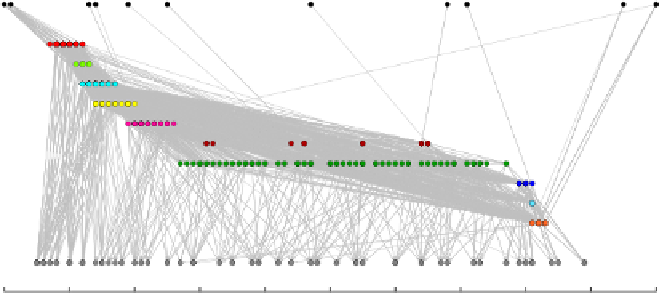Information Technology Reference
In-Depth Information
S
G1
G2
G3
G4
G5
G6
G7
G8
G9
G10
M
0.0
0.1
0.2
0.3
0.4
0.5
0.6
0.7
0.8
0.9
1.0
Fig. 11.2. C. elegans layout of sensorial (S), motor (M) and non-pharyngeal neuronal cells, and
its connectivity. Neurons in the same ganglia are given the same vertical oset for clarity: G1) an-
terior ganglion, G2) dorsal ganglion, G3) lateral ganglion, G4) ventral ganglion, G5) retrovesicular
ganglion, G6) posterolateral ganglion, G7) ventral cord neuron group, G8) pre-anal ganglion, G9)
dorsorectal ganglion, G10) lumbar ganglion. The bottom ruler shows the longitudinal assigned
coordinates, with values 0.0 and 1.0 for the head and tail of the worm respectively.
neurons in C. elegans have a simple uni- or bipolar morphology that is typical for
invertebrates. Synapses between neurons are usually formed en passant and each
cell has multiple presynaptic regions dispersed along the length of the axon.
The neuronal network connectivity of the C. elegans can be represented as a
weighted adjacency matrix of 279 nonpharyngeal neurons, out of a total of 302
neurons (pharyngeal neurons are not considered in this work because they are not
reported in the above mentioned database). The abstraction at this point consists
in to assume that the nervous system of the C. elegans can be modeled as a network,
where nodes represent the center of the cell bodies, and the links represent synapses,
see Fig. 11.2. The order and nomenclature of the neurons in the matrix follows that
of [12], for a detailed biological record of the dataset see [7]. The position of neurons
has been dened in the data set as follows: i) neuron location is considered at the
center of the cell body projected onto the anterior{posterior axis of the worm, ii) a
neuron is assumed to make a single connection to a given sensory organ, iii) the
position of each muscle is dened as the midpoint between anterior and posterior
extremities of the sarcomere region, and iv) there is a lack of data specifying the
location of individual synapses in the worm.
11.3. Optimization Model Problem
Assuming that the neuronal wiring of C. elegans has been optimized by natural
evolution, it seems plausible to formulate an optimization model problem whose re-
sults will reproduce a neuronal layout in agreement with the real data, and support
then the hypothesis of the wiring economy principle. The model must be robust









